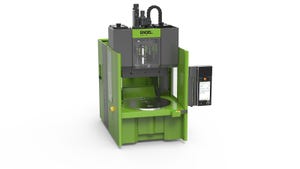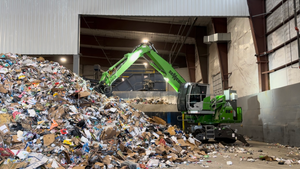Do you REALLY know your melt temp?
During the past few weeks I was in three different countries and five molding shops. I'm always asked to look at some problem. One of the first things I do when I'm in a molding shop is ask if the molder has the material spec sheet and if he is molding the material at the proper temperature.Interestingly enough, each shop proudly showed me the technical data. Sadly, they all pointed to their machines, noted the temperature on the heaters and pronounced it to be the material's melt temperature. Really?
September 6, 2011
During the past few weeks I was in three different countries and five molding shops. I'm always asked to look at some problem. One of the first things I do when I'm in a molding shop is ask if the molder has the material spec sheet and if he is molding the material at the proper temperature.
Interestingly enough, each shop proudly showed me the technical data. Sadly, they all pointed to their machines, noted the temperature on the heaters and pronounced it to be the material's melt temperature. Really?
|
Guest author Bill Tobin offers his tips on best practices for measuring melt temperature. |
The melt temperature is only slightly controlled by the heaters. The primary determinant of melt temperature is the screw and back pressure. Why this is a less-than-commonly-appreciated/known fact is beyond me.
Melt temperature is a main determinate in your entire process. Too hot or too long residence time (where the heaters will become a factor) and you'll burn the material. If the melt is too cold, you'll get brittle parts, weld lines and have to use higher than normal pressures to fill and pack the part.
There's little sin to work on either end of the material's melt point range. The resin companies publish the data conservatively. However, being far below or above the temperature range is never a good practice.
Melt temperature measurement mistakes come from two basic causes:
CAUSE #1 - Reading the machine's output
Never believe the machine settings as a measure of melt temperature. The machine's heaters are there to melt the material in contact with the barrel to provide a lubricant layer for the screw to do its job. What you see in the temperature setting of the front, middle and rear zones is the barrel temperature, not the temperature of the material.
In-line melt pyrometers are a bit costly but probably are the best measure of the shot's temperature. Unless you specifically ask for it, it is not a common accessory for your machine.
CAUSE #2 - Technique
Most techs simply back off the barrel and squirt purge onto the machine or a container, and then put the pyrometer needle into the puddle. When the temperature ceases to increase, they declare the highest temperature recorded to be the melt temperature. There are a few things dramatically wrong with this approach:
Problem #1: Startup - If you take the material temperature after the machine has been idle for a few minutes, you've let the material 'cook' under the influence of the heaters. The temperature you get immediately will be higher than the process temperature of the material in production. If you purge a few shots and then take the temperature, the melt temperature will be lower than the process temperature in production because it didn't have the luxury of sitting under heat when the screw was idle during packing and cooling.
Problem #2: Temperature - Let's assume your material should be 480°F. Let's further assume the molding area is at 80°F. This means you're plunging a COLD pyrometer into a HOT melt. For purposes of comparison, the differences in temperature is very close to plunging your needle into liquid nitrogen that boils at -320°F. Since plastic cannot conduct heat very well, we generally call it an insulator. When we plunge a very cold needle into a molten mass of plastic, the plastic coats the pyrometer's needle immediately and insulates it from the rest of the melt. Because of this insulating layer, you're probably getting a false (lower) reading than the actual melt temperature.
Problem #3: Time - Watch five techs take the melt temperature and you will see they take their readings at different time intervals and with various stirring, poking or other movements. Most purgings are a thick liquid. Stirring it introduces air pockets that will lower your reading. If you have a large enough purge puddle and you put the pyrometer's needle in the center of the mass, it will equilibrate and hold its temperature. Putting it too close to the air or too close to the bottom of the puddle (that is perhaps sitting on the steel of the machine) will also give you a false reading.
RJG Associates many years ago recognized this problem. Scientific or any other kind of Molding is based on the premise of temperature control of the material. Because of this the company developed the '30-30-30' method for determining melt temperatures.
THE FIRST '30' - Let the machine stabilize for 30 shots or run for 30 minutes. This will give you a production melt temperature.
THE SECOND '30' - Preheat the pyrometer's needle to within 30°F of what you believe the melt temperature to be. This eliminates the thermal shock of a cold needle into a hot melt that will produce the insulating layer mentioned previously.
THE THIRD '30' - Put the pyrometer's needle into the center of the purge and DON'T MOVE or WIGGLE IT. Take your reading 30 seconds later.
This method minimizes the instrumental and people errors induced in measuring the actual melt temperatures. For those of you measuring in metric, instead of '30-30-30' you convert to '30-15-30' and measure in Celsius. The fastest adjustment to the melt temperature is with back pressure.
The shops I visited measured 'good' melt temperatures doing it Their Olde Waye, and repeatedly obtained a temperature 20°F lower using the 30-30-30 method. More importantly, the 'Olde Waye' showed a 25°F difference between technicians. Using the 30-30-30 method showed only a 5°F spread.
The next time you think you're molding properly, take the melt temp - first your way and then using the 30-30-30 method. You'll be surprised what you find.
About the author: Consultant Bill Tobin ([email protected]) is a regular contributor to PlasticsToday. You can sign up for his newsletter at www.wjtassociates.com.
About the Author(s)
You May Also Like



